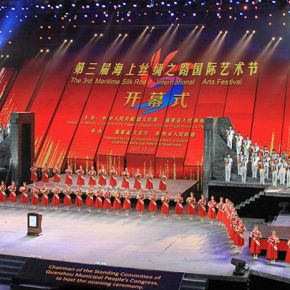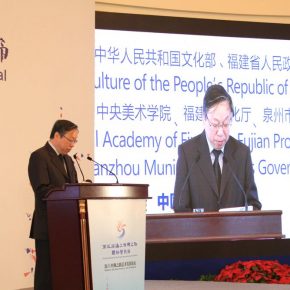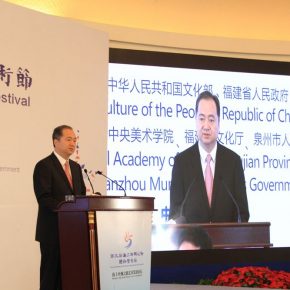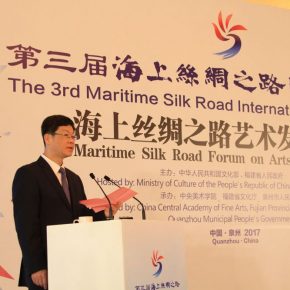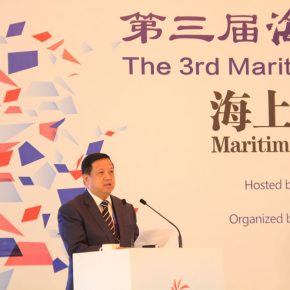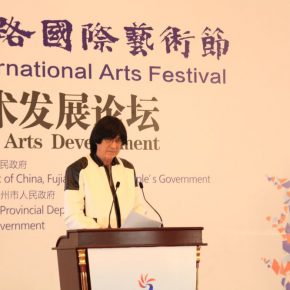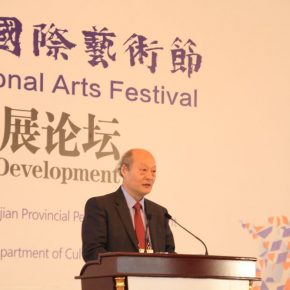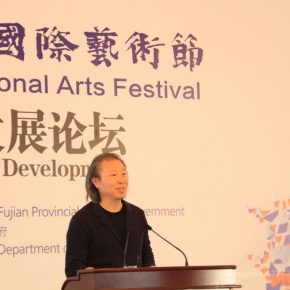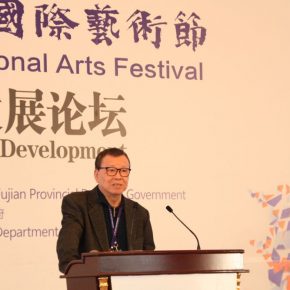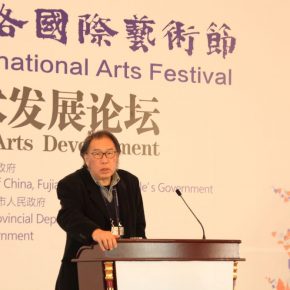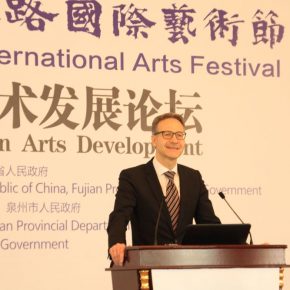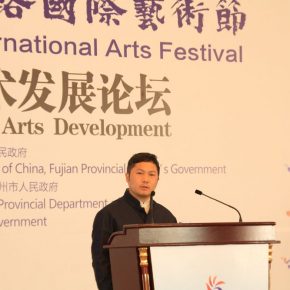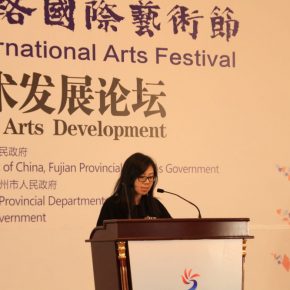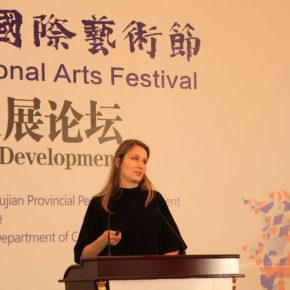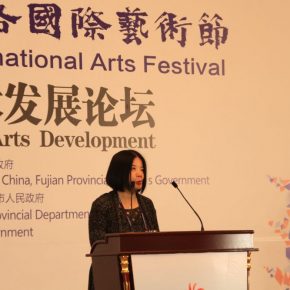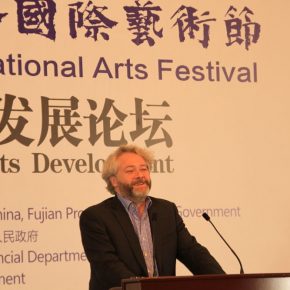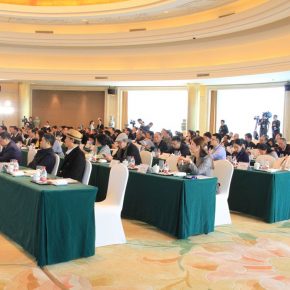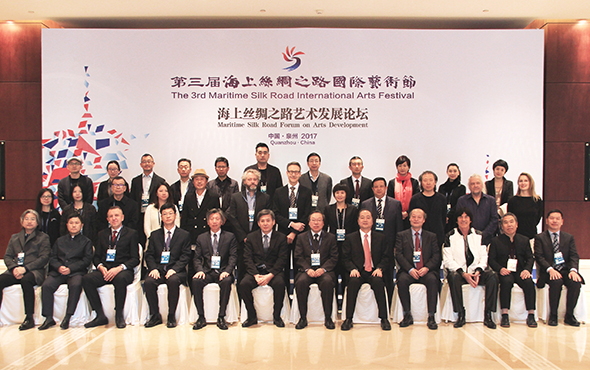
From December 10 to December 15, 2017, the 3rd Maritime Silk Road International Arts Festival was staged in Quanzhou, followed by 10 projects including the opening ceremony of Maritime Silk Road International Arts Festival, Maritime Silk Road Forum on Arts Development, China – Central and Eastern Europe Cultural Season in Quanzhou, Maritime Silk Road Intangible Cultural Heritage Exhibition, International Puppet Festival, International Nanyin Concert. The organizers are making efforts to create a permanent platform for displays and exhibitions, to attract more cultural resources from other countries and regions along the Maritime Silk Road, gathering in Quanzhou and building Quanzhou as a hub for the Maritime Silk Road’s culture.
On December 11, jointly hosted by the Ministry of Culture and Fujian Provincial People’s Government, co-organized by CAFA, the Fujian Provincial Department of Culture and the Quanzhou Municipal People’s Government, “Maritime Silk Road Forum on Arts Development” was held in Quanzhou, China. Hong Jiexu, Vice Governor of Fujian Provincial People’s Government, Xie Jinying, Director General of the Bureau for External Cultural Relations, the Ministry of Culture of PRC, and Zheng Xincong, Secretary of the Municipal CPC Committee, Director of the Standing Committee of the Municipal People’s Congress, addressed the opening ceremony. Kang Tao, Major of the Quanzhou Municipal People’s Government, presided over the opening ceremony. As the central program of the 3rd Maritime Silk Road International Arts Festival, the forum focused on the multi-dimensional development of arts on the Silk Road in the name of art. Starting from “big culture” and “big art”, the forum was divided into three topics based on cross-culture and a global perspectives, invited were 16 influential distinguished guests and scholars from the fields of art, music, drama, architecture, poetry, cultural institutions, photography, to deliver lectures and dialogues on the research and practice in their field, fully exploring the historical and cultural connotation of the Maritime Silk Road, and exploring the position, meaning and value of the arts in the Maritime Silk Road’s culture, and especially in the development of the Maritime Silk Road in the 21st century, in order to present the history and current situation of culture & arts, outlining the future development prospects. Prof. Yu Ding, Chief Curator of the forum, Dean of the Institute of Arts Administration and Education, CAFA, presided over the speeches of each forum section.
Past, Present and Future: Arts Development under the Influence of Maritime Silk RoadFirst of all, Fan Di’an, President of CAFA delivered a keynote speech at the forum. He believed that we have never fully found the path of propagation that has brought influence, but the establishment of the Silk Road has offered a smooth pathway between the East and the West. Chinese paintings, sculptures, crafts, architecture, music and theater were constantly transported to distant countries and areas via the Land-Sea Silk Road.
The well-known poet Xi Chuan also discussed the issue of cultural communication from the commerce and trade of the Silk Road. He mentioned that our use of English as an international working language has shown the cultural structure of the current world. In his opinion, the Chinese economy and culture was continuously developing, so that recalling the promotion of English in the world would inspire the spread of Chinese. As we move beyond the environment in which English is used to describe the world, the appearance of world culture must be different from the present culture. Guan Xia, Composer and Director of the China National Symphony Orchestra, also believed that the cultural communication lay behind the Silk Road that started with commodity exchange. Starting from the specific case of the development of Nanyin, native music in Fujian, he shared his thoughts on how to initiate cultural innovation under the context of developing the New Maritime Silk Road, and how to improve our cultural innovation capability. Guo Meixia, Deputy Director of the Department of Publicity and Education, Researcher of the Palace Museum, started from the phenomena of Chinese and Western cultural communications which happened in the Forbidden City during the Ming and Qing Dynasties and shared how the Forbidden City communicated with people all over the world from ancient times.
Deke Erh, a photography artist, believed that it was the ancient sailing ships invented by our ancestors that made such a broad geographical concept of the territory for the ancient Chinese people. Unfortunately, we have not fully inherited the ancient sailing manufacturing technology. At the same time, he talked about the studies in oversea Chinese letters and the collation of oral history. Combined with the topic of the forum, Zhu Pei, a contemporary Chinese architect, started from the concept of the Maritime Silk Road and selected three architectural cases for analysis. He believed that art had a strong power to recreate when looking for cultural roots.
The Shared Value of Art: Art Fusion in the Context of Globalization?Nowadays, as we are located in the background of globalization, the development of contemporary art showcases diversified ecological features. The mixed, diverse and cross-cultural ideas that have formed a common feature in the arts including painting, music, drama and so on. The integration of Eastern and Western art on the ancient Silk Road created the unique appearance of this nation. In the background of the new era, the new Silk Road Economic Belt offers the possibility of another blending between them. It also shows the significance of the forum’s theme of “shared value”. Didier Marouani, Composer and Creator of the Electronic band Space, was invited to deliver a keynote speech. Through this opportunity with the Maritime Silk Road International Arts Festival, Didier Marouani hoped to have more opportunities for communication with China and hoped to use the synthetic music to work together with the Chinese symphony orchestra in the future.
Alexander Koch, Former President of the German Historical Museum, thought that the Maritime Silk Road was a modern term that gave us a vivid demonstration of the relationship between current cultural communications, commerce and people at that time. The culture of Maritime Silk Road has reflected our shared heritage and cultural diversity for centuries. He believed that it was this shared heritage, the common historical and cultural diversity that opened the door for international communication, allowing people to enter the globalized world.
Fran?ois Michaud, Chief Curator at the Museum of Modern Art of the City of Paris, researched the transformation of East-West artistic relations through the case of Chinese artists over two eras. Fran?ois Michaud believed that if any artist wanted to make an artistic breakthrough, he had to communicate with different people and explored different forms of art. He started from the long history of the Tea Road, Valentyn Velychko, Former Cultural Counselor at the Embassy of Ukraine to the People’s Republic of China, saying that the routine for tea trade and logistics was a spiritual connection and a cultural channel across countries and regions along the Belt and Road such as Ukraine.
Gary Hill, an American artist, has conducted his cultural studies profoundly and formed artistic creations in different communities in many cities throughout the world during these years, and has a profound reflection on both the contemporary culture and traditional cultural traditions. He believed that the blending of cultures should be based on respecting the local culture, thus gaining the best effect of cultural communications by maintaining the equality of both cultures. Another American contemporary artist Magdalena Hill focused on sharing her transformation process in spiritual beliefs. She believed that the impact brought by the new culture allowed people to see the changes and innovations of the world, as well as cultural diversity.
In addition to talking about the multi-dimensional art development of the Maritime Silk Road, the forum also focused on the development of Quanzhou and the ecological protection of the Maritime Silk Road. Xie Xiaochuan, Deputy Director of the National Museum of China, delivered a speech on how Quanzhou could make its own contribution to the development of the Maritime Silk Road in the 21th century, on the basis of a glorious history. He believed that strengthening the exchange and cooperation was a key to cultural progress for Quanzhou in the face of new times and new situations. Hsieh Pei-ni, Director of the Department of Cultural Affairs, Taipei City, delivered a speech on the basis of the future development of Quanzhou, and shared the achievements in planning and practicing when she was Director of Kaohsiung Art Museum and Director of the Department of Cultural Affairs, to analyze the great role of cultural factors in urban development. Chen Yan, Assistant Researcher from the Cultural Development Strategy Research Center of Fujian Art Research Institute, delivered a report which started from the protection of the cultural ecology of the South of Fujian province during the past 10 years and talked about the historic and cultural heritage of the Maritime Silk Road.
At the end of the forum, Fan Di’an gave a concluding speech. He believed that this forum has formed a rare cross-time, cross-disciplinary and cross-cultural academic communication, and it was a forum of high academic standard. In conclusion, the forum has formed new achievements in three aspects: Firstly, it further recognizes Quanzhou’s value as the entry to the ancient Maritime Silk Road and the place where Chinese and foreign cultures meet; secondly, it further recognizes that cultural integration is an important precondition for cultural innovation; thirdly, it further realizes that cultural communications are the basic path for mutual understanding of different cultures and a solid foundation for building a common community of human destiny.
Text and photo by Yang Zhonghui, translated by Chen Peihua and edited by Sue/CAFA ART INFO


